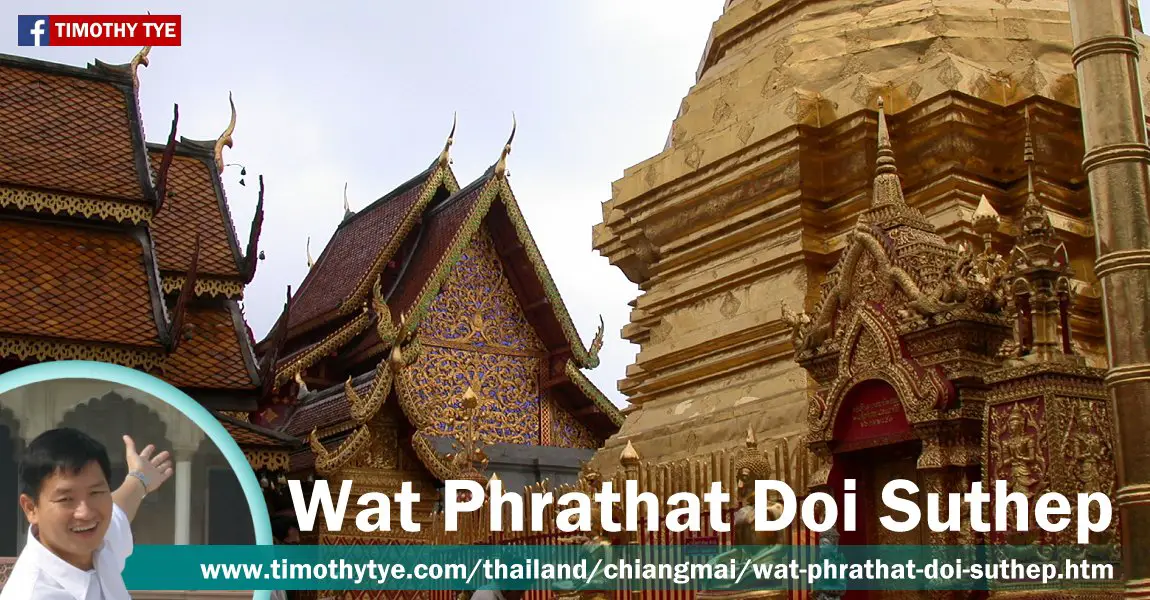 Wat Phrathat Doi Suthep, Chiang Mai (25 December, 2002)
Wat Phrathat Doi Suthep, Chiang Mai (25 December, 2002)
Wat Phrathat Doi Suthep (GPS: 18.80489, 98.9216; Thai: วัดพระธาตุดอยสุเทพ
 ), or by its full name, Wat Phra Boromathat Doi Suthep, is one of the most important temples in Chiang Mai, Thailand. It is located half-way up the 1601-meter Doi Suthep mountain, on a ridge overlooking Chiang Mai. The people of the area considers Doi Suthep and the adjacent 1685-meter peak, Doi Pui, as sacred, as they are the abodes of Pu Sae and Ya Sae, the guardian spirits of the city.
), or by its full name, Wat Phra Boromathat Doi Suthep, is one of the most important temples in Chiang Mai, Thailand. It is located half-way up the 1601-meter Doi Suthep mountain, on a ridge overlooking Chiang Mai. The people of the area considers Doi Suthep and the adjacent 1685-meter peak, Doi Pui, as sacred, as they are the abodes of Pu Sae and Ya Sae, the guardian spirits of the city.The decision to built Wat Doi Suthep came about out of an accident. In 1371, the monk Sumana was bringing a sacred relic from Sukhothai to be enshrined in Wat Suan Dok. However, during the enshrining of the relic, an accident occured, causing the relic to split into two. According to superstition, it is inauspicious enshrined both pieces of relic at Wat Suan Dok.
A new site was to be found to enshrine the second piece. To do this, the relic was placed in a reliquary on the back of a white elephant. The elephant was then set free to roam on its own. Off it went in the direction of the mountains. It stopped three times, the first at a lower hilltop now known as Doi Chang Non, meaning Hill of the Sleeping Elephant. Eventually the elephant arrived at a spur on Doi Suthep, at a place where there lived a hermit by the name of Wasuthep. Here it trumpeted three times, went in circles for three times, then knelt to the ground and promptly died.
The believers, who have been following after the elephant, regarded this as an auspicious sign, and determined that the spot where the elephant died should be the site to build a temple to enshrine the relic.
The original temple built in the 14th century comprises a 7-meter chedi. At the end of the 15th century and the turn of the 16th century, the chedi was enlarged to its present form, standing 16 meters tall and has a base which is 12 meters in diameter.
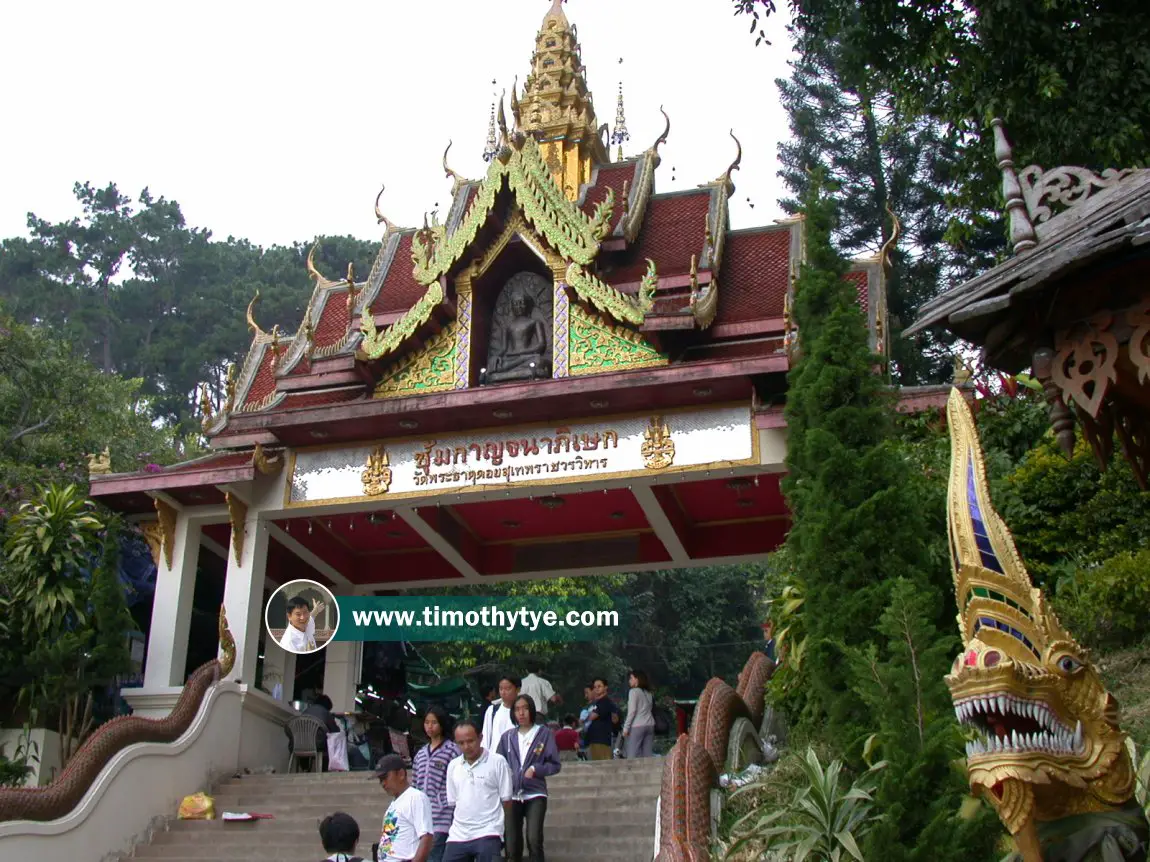 Entrance arch to Wat Phrathat Doi Suthep, Chiang Mai (25 December, 2002)
Entrance arch to Wat Phrathat Doi Suthep, Chiang Mai (25 December, 2002)
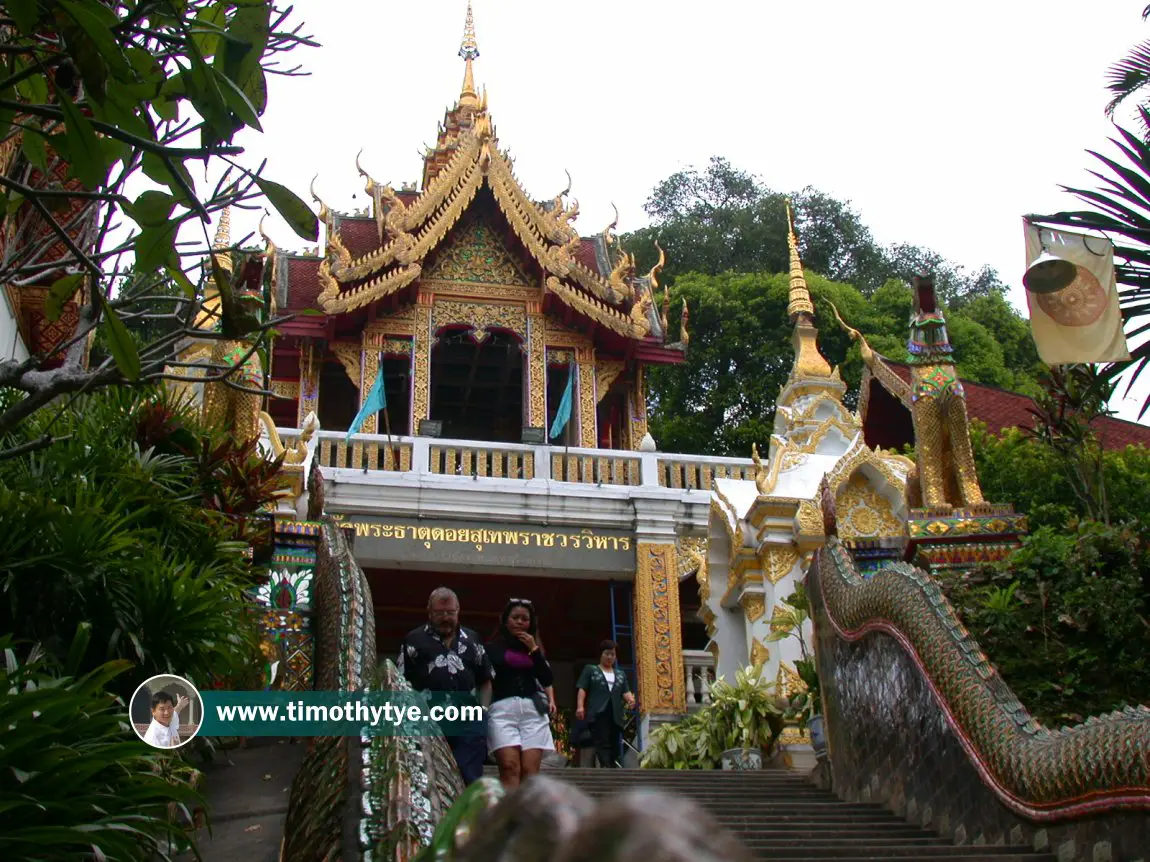 The first building upon arriving at Wat Phrathat Doi Suthep, Chiang Mai (25 December, 2002)
The first building upon arriving at Wat Phrathat Doi Suthep, Chiang Mai (25 December, 2002)
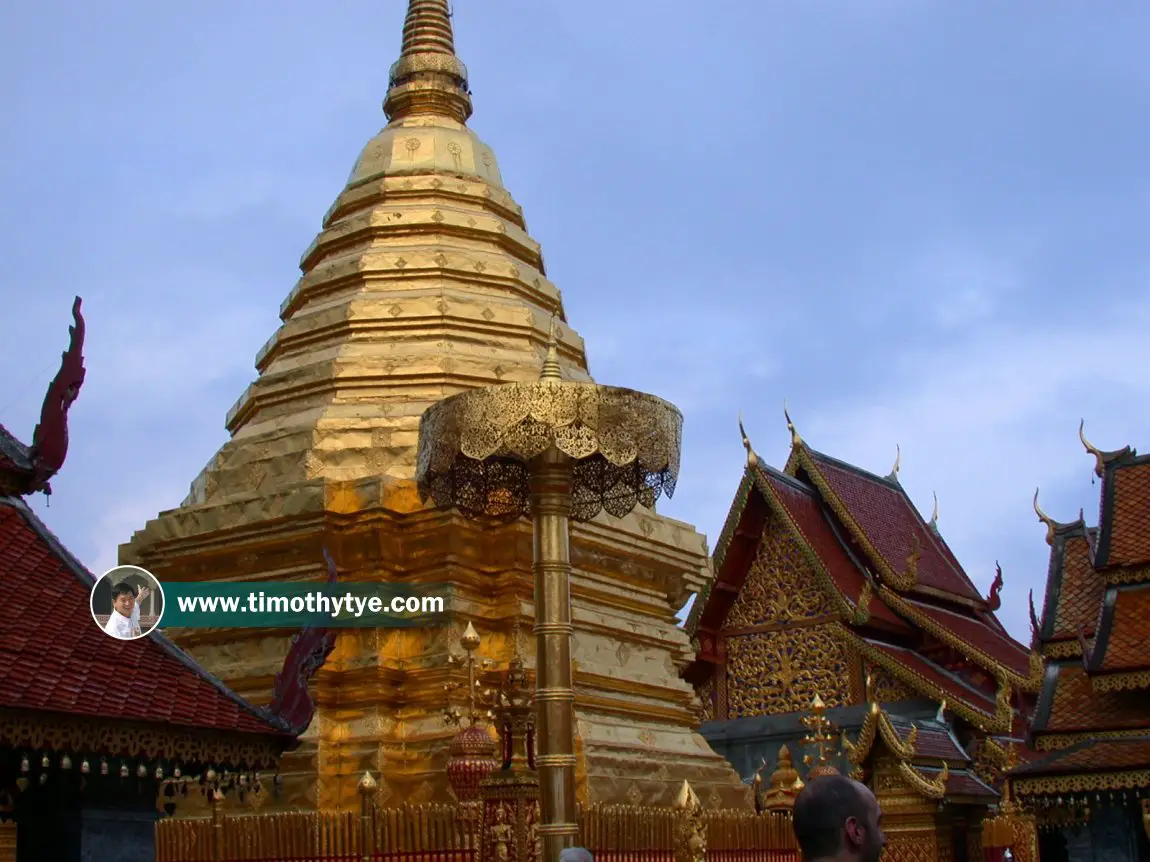 The chedi of Wat Phrathat Doi Suthep, with a chat or parasol. (25 December, 2002)
The chedi of Wat Phrathat Doi Suthep, with a chat or parasol. (25 December, 2002)
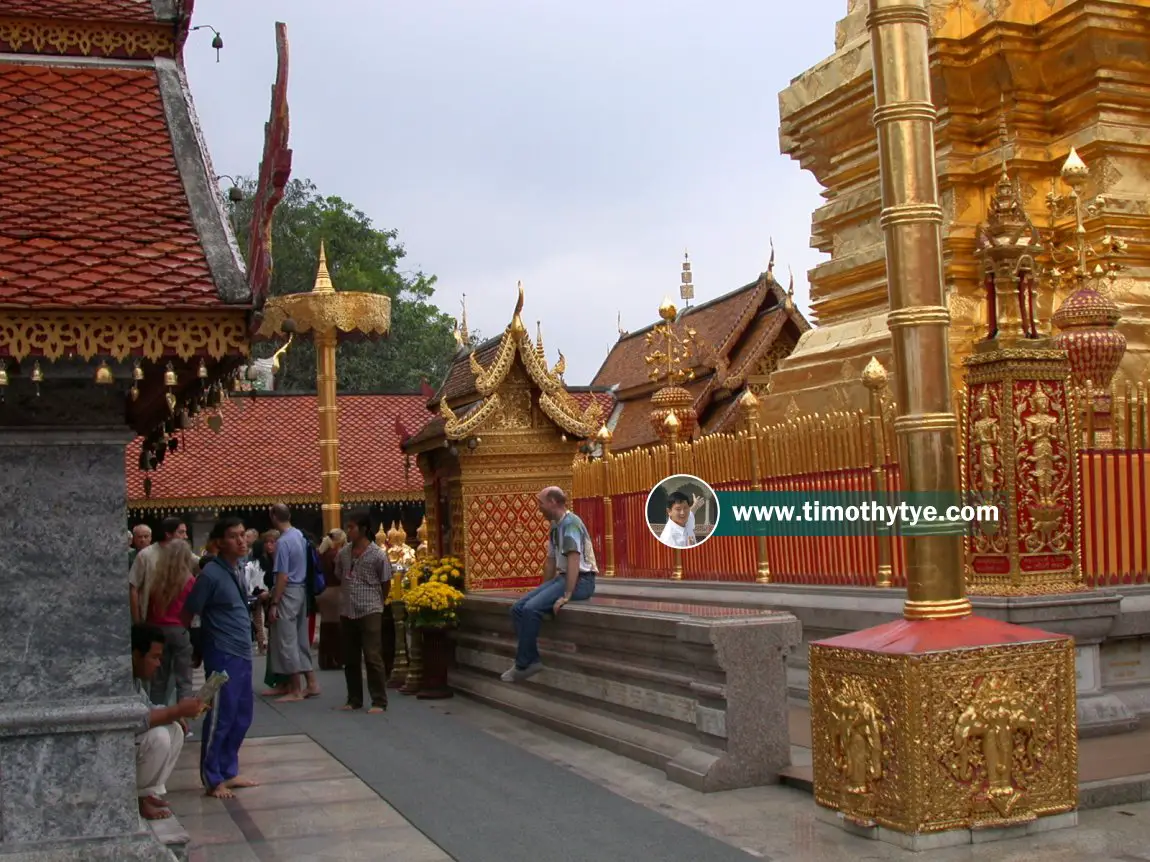 At each cardinal direction of the chedi's enclosure is a small shrine. (25 December, 2002)
At each cardinal direction of the chedi's enclosure is a small shrine. (25 December, 2002)
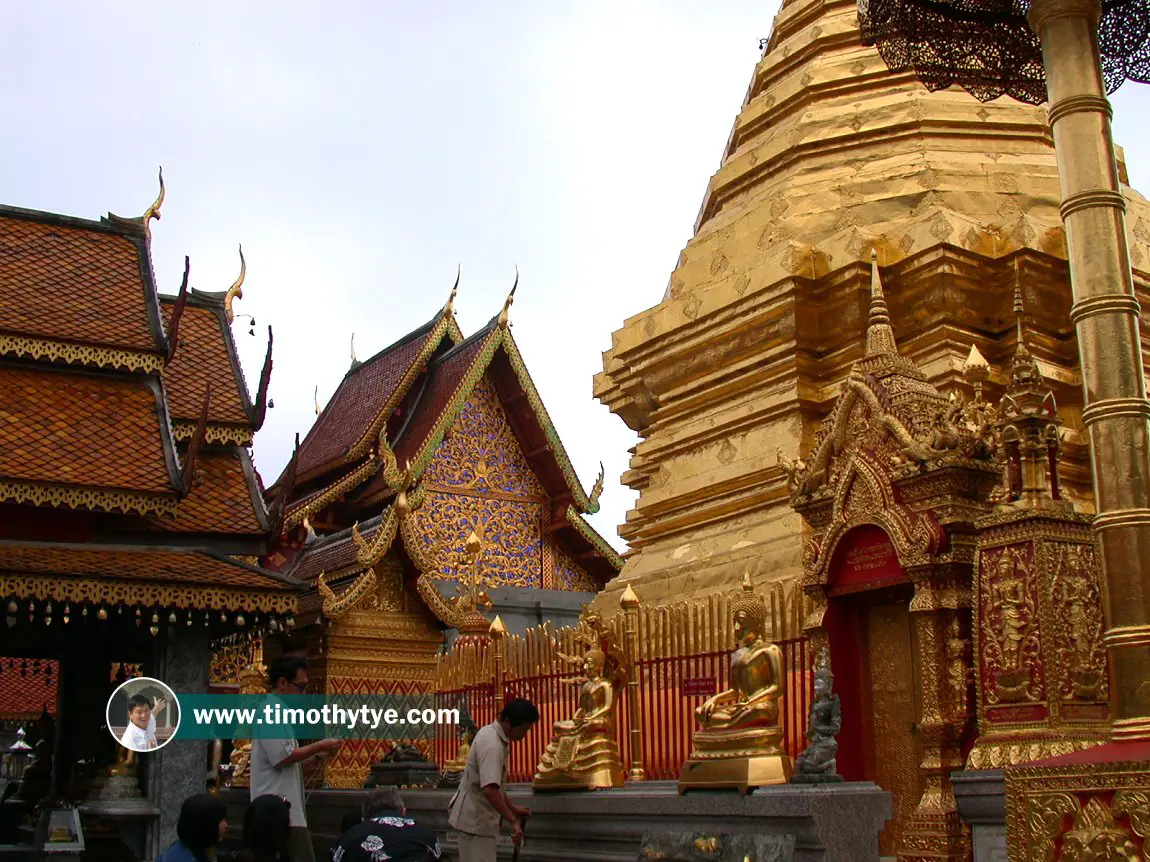 Buddha statues line the fence of the chedi of Wat Phrathat Doi Suthep. (25 December, 2002)
Buddha statues line the fence of the chedi of Wat Phrathat Doi Suthep. (25 December, 2002)
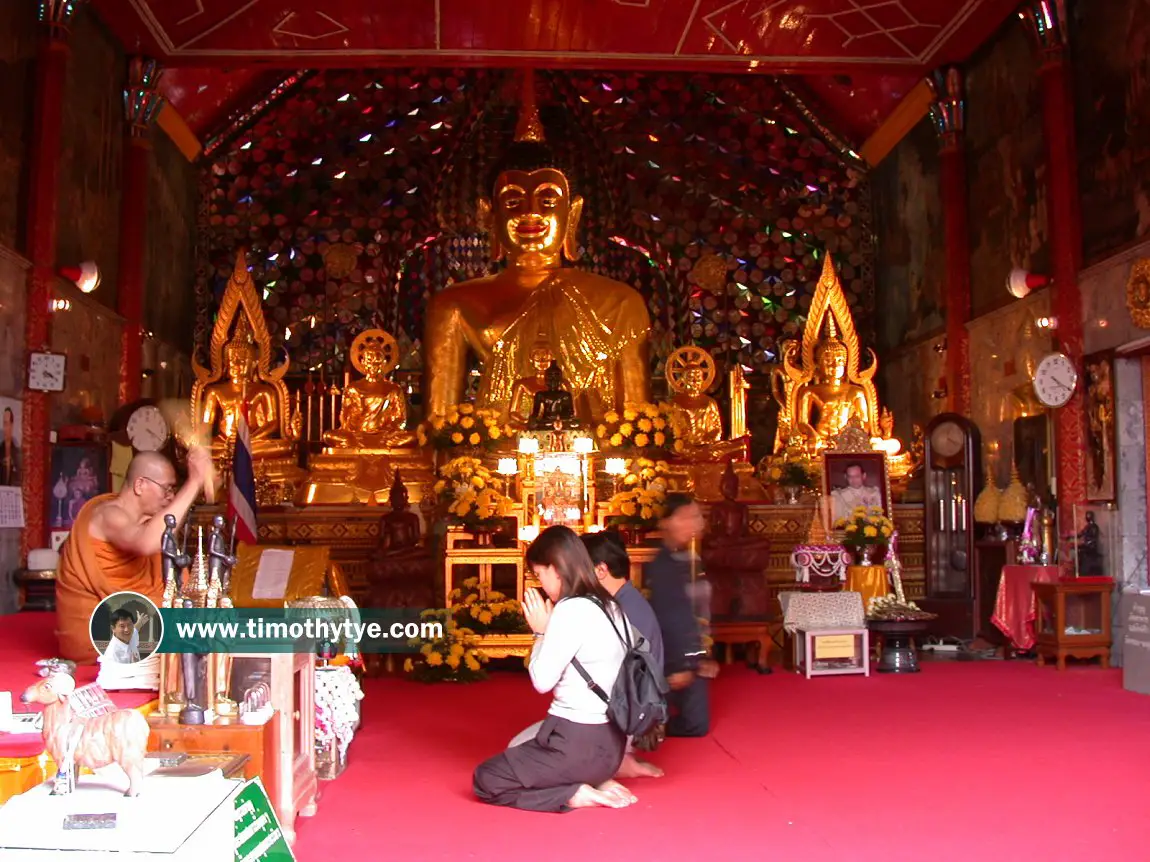 Buddha images of various sizes in a viharn or assembly hall of Wat Phrathat Doi Suthep. (25 December, 2002)
Buddha images of various sizes in a viharn or assembly hall of Wat Phrathat Doi Suthep. (25 December, 2002)
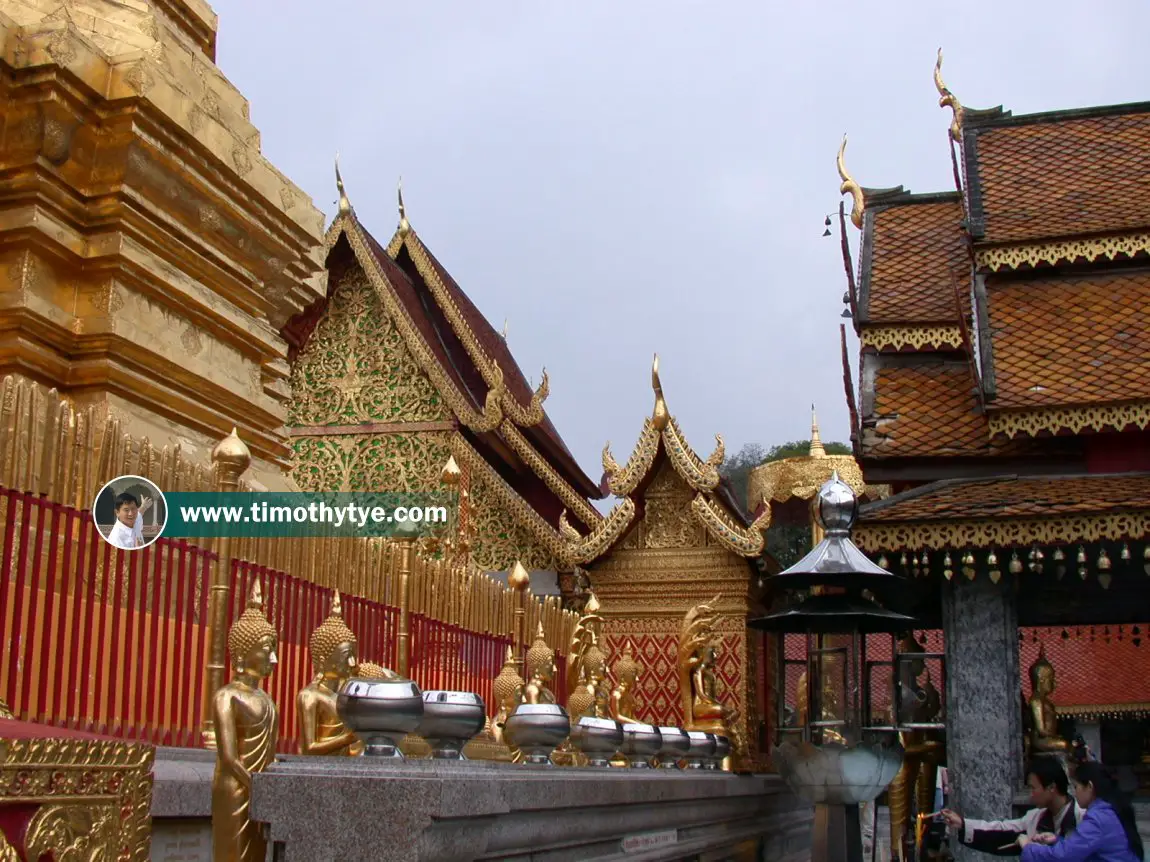 A row of alms bowl at Wat Phrathat Doi Suthep. (25 December, 2002)
A row of alms bowl at Wat Phrathat Doi Suthep. (25 December, 2002)
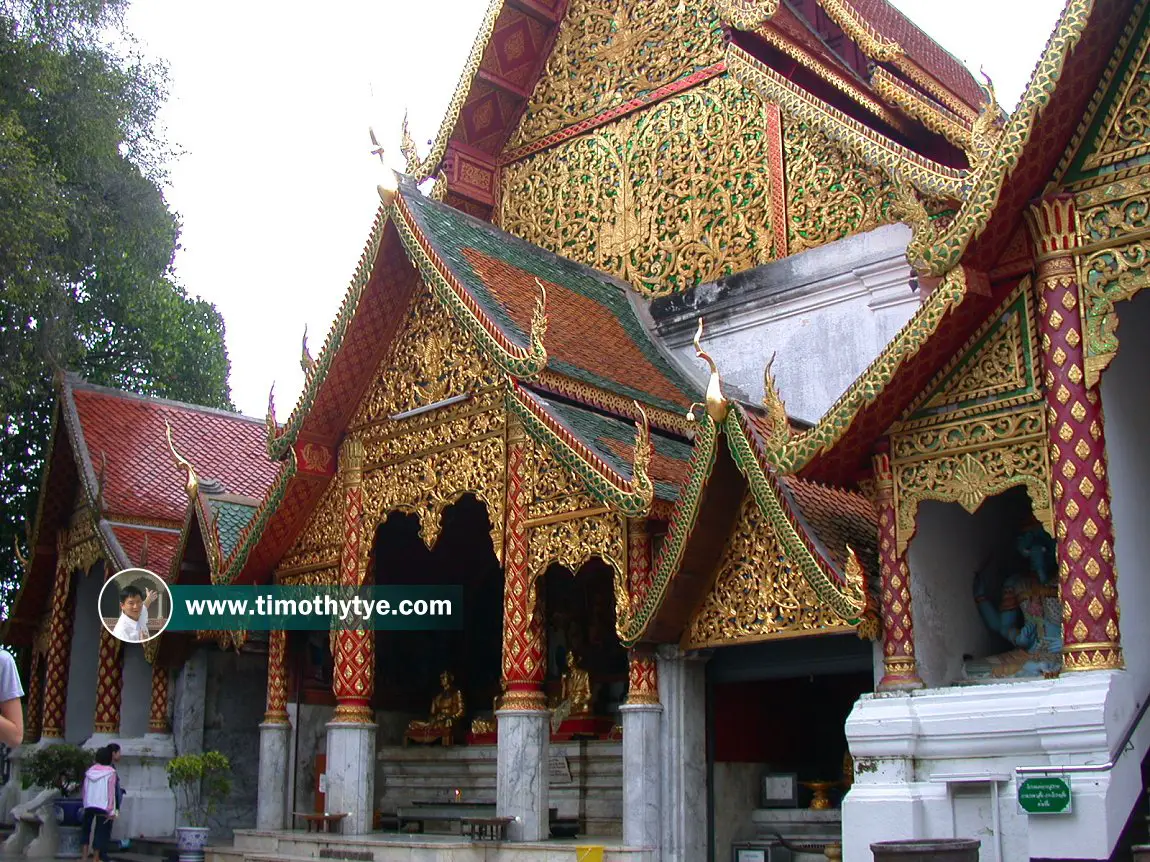 The numerous shrines at Wat Phrathat Doi Suthep. (25 December, 2002)
The numerous shrines at Wat Phrathat Doi Suthep. (25 December, 2002)
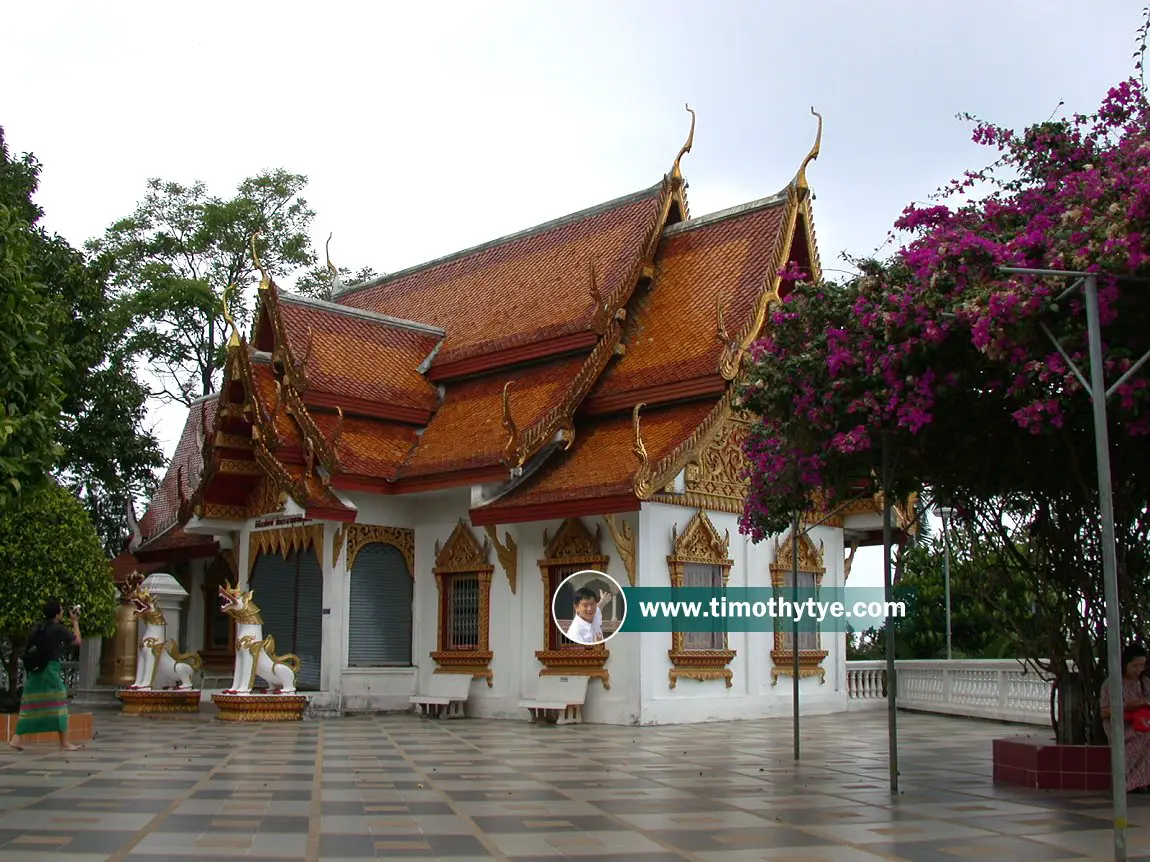 With its entrance flanked by a pair of guardian lions, this is possibly the ubosot or ordination hall of Wat Phrathat Doi Suthep. (25 December, 2002)
With its entrance flanked by a pair of guardian lions, this is possibly the ubosot or ordination hall of Wat Phrathat Doi Suthep. (25 December, 2002)
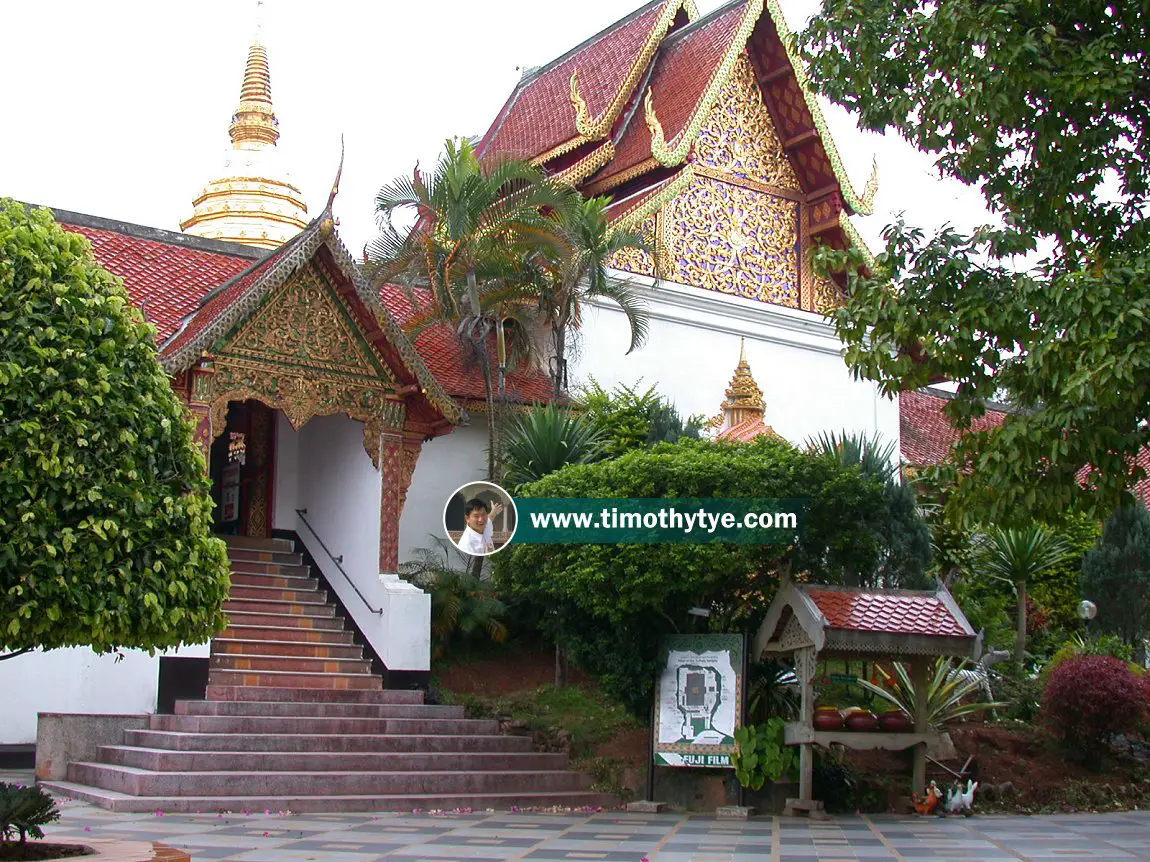 One of the many buildings in the Wat Phrathat Doi Suthep complex. (25 December, 2002)
One of the many buildings in the Wat Phrathat Doi Suthep complex. (25 December, 2002)
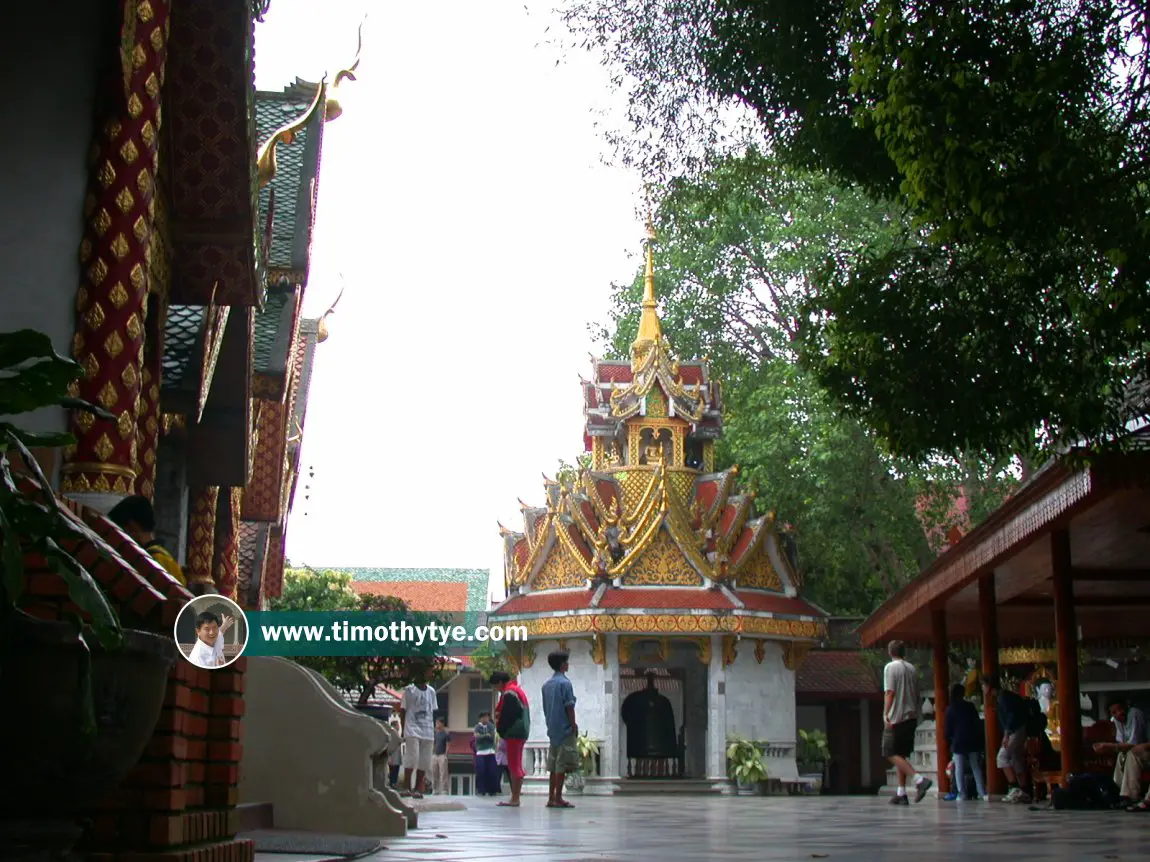 The bell tower of Wat Phrathat Doi Suthep is an octagonal building with triple-layer roofs. (25 December, 2002)
The bell tower of Wat Phrathat Doi Suthep is an octagonal building with triple-layer roofs. (25 December, 2002)
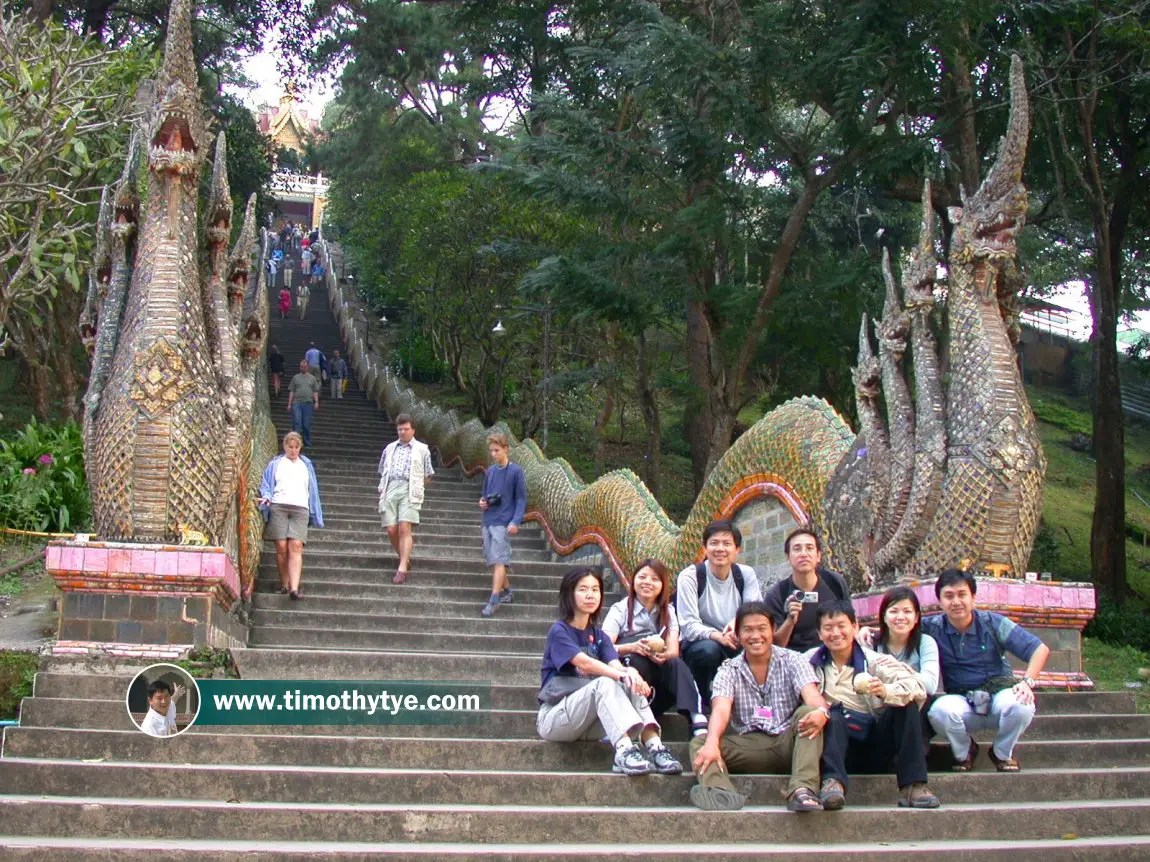 Group shot with my friends and tour guide at the naga staircase to Wat Phrathat Doi Suthep. (25 December, 2002)
Group shot with my friends and tour guide at the naga staircase to Wat Phrathat Doi Suthep. (25 December, 2002)
Getting there
The easiest way to pay a visit to Wat Doi Suthep is to book a tour package in Chiang Mai. If you are an independent traveler, it is best that you drive there. Take Huai Kaeo Road which leads out of the northwest corner of Old Chiang Mai. This leads to the winding hill road built in 1935 by the followers of Kruba Srivichai, a revered monk of Lanna Thai. Wat Doi Suthep is at Km 14 marker. You won't fail to miss it. There are parking lots, food stalls and souvenir stalls.To take public transport, look for songtheaws (red-color pick-up trucks) going there. You can find them parked in front of Chiang Mai University and in front of Chiang Mai Zoo. Once they get 6 passengers, they are ready to go. The journey should cost about 30 baht one way. You can hire the songthaew for 150 baht one way. Tuk tuk are not allowed to go to Doi Suthep. The traditional way to reach the temple is by climbing the 200-step staircase, built in the 16th century by the ruler Phra Mekuti. It is flanked on either side by undulating naga-makara balustrades. This takes you right up to the main facade of the temple. Entrance fee is 30 baht.
An alternative is to use the funicular tram, a sort of box-like contraption that carries passengers up the hill to the temple. It travels at a speed of 60 meters per minute. Entrance fee including two-way tram ride is 50 baht.
When to visit
It is best to visit during weekdays, Mondays to Fridays, as it is less crowded. Many local worshippers visit it during weekends and public holidays. The temple is open from 6:00am to 8:00pm.What to see
Let me show you around Wat Phrathat Doi Suthep. Let's use the staircase. Yes, it is quite a tiring climb, but fun to see the temple coming nearer and nearer.At the top of the stairs, you see two yak, green, fierce-looking guardians. They are housed in small chapels on either side of the staircase, and are installed there to offer "protection" to the terrace. In front of you is a walled enclosure.
On the right of an old jackfruit (nangka) tree is a pavilion or shrine with the image of Wasuthep, the hermit who was staying at the spot when the white elephant arrived. You can identify him by the tiger-stripe robe that he dons. On the other side of the jackfruit tree is the statue of the white elephant along with the portable reliquary that carried the relic.
Nearby is an ubosot with the statue of Mae Thorani, the earth goddess, in her usual pose of wringing her hair to release water that will flood and drown the army of Mara which was attacking the Buddha. Along the side walls are rows of bells which are rung by devotees.
The Cloister of Wat Doi Suthep The chedi of Wat Doi Suthep is enclosed within a cloister, or phra rabieng. It was last renovated by Chao Kawila at the beginning of the 19th century. The phra rabieng is lined with Buddha images.
Sala Khru Ba Srivichai All around the cloistered compound are additional buildings, or viharns. The largest is on the side of the main entrance. This one is called Sala Khru Ba Srivichai, named after the monk who built the road up Doi Suthep in 1935. It was however much older than the monk himself, being built in 1806. On its walls are murals telling the story of how the wat was founded. The Chedi of Wat Doi Suthep
The chedi is a golden spire and look exquisite against the blue sky. It is sheathed completely with gilded copper plates. As this is a phra that, meaning a sacred relic is housed inside, the chedi is fenced by a railing that is painted red with gilded tips. On feast days, ,male devotees are allowed to circumnambulate clockwise around the chedi inside the fenced compound. At each corner of the railing is a towering golden umbrella. These are Burmese-style sacred parasols called chat.
The other Viharns of Wat Doi Suthep
Now let's walk around the compound in the clockwise direction. The viharn on the west side contains an image of the Buddha called Pho Luang Oon Muang. Devotees often stop here to offer prayers to the image as well as to the chedi. On the north side of the compound is another viharn, also built in 1806. Inside is the Buddha image known as Phra Purahatsabodhi Boromathat, also known as the Thursday Buddha. Devotees born of Thursdays pay homage to this Buddha image. Finally, on the east side is a small viharn with the Buddha image known as Pho Luang Than Chai.
Wat Phrathat Doi Suthep is  on the map of Chiang Mai
on the map of Chiang Mai
List of Wats in Chiang Mai and Wats in Thailand
[an error occurred while processing this directive] Latest updates on Penang Travel Tips
Latest updates on Penang Travel Tips
 Map of Roads in Penang
Map of Roads in Penang
Looking for information on Penang? Use this Map of Roads in Penang to zoom in on information about Penang, brought to you road by road.Disclaimer
Please use the information on this page as guidance only. The author endeavours to update the information on this page from time to time, but regrets any inaccuracies if there be any.
Copyright © 2003-2025 Timothy Tye. All Rights Reserved.

 , Chiang Mai
, Chiang Mai Go Back
Go Back